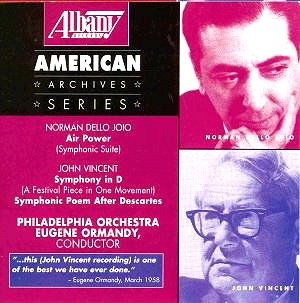We
know we are in safe hands when the author of the notes is John
Proffitt. His guideis extensive and thankfully dense with facts
rather than the usual attitudinising or retreat into technical
undergrowth and embalming fluid.
Dello
Joio's score for TV (an ambitiously confident co-production
between the CBS network and the USAF) is easy on the ear. This
is high-rolling film music like a ripe cross between Korngold
and Walton, both in grandeur and sentiment (Lonely Pilot's
Letter Home). There is also some olde-worlde Edwardian charm
(à la Barber's Souvenirs) and a post-card Russian
dance (a fine curio of that moment in time around 1943-1945
when Russo-American relations were blissfully allied) indebted
to Khachaturyan and Gliere. There is a typically gong-darkened
Japanese interlude and the intoxicating optimistic excitement
of Liberators. Not profound music then but memorable and
full of colour.
John
Vincent will be known to even fewer than Persichetti and Dello
Joio. John Proffitt writes about him in great detail in the booklet.
Vincent's music bubbles with Respighian effulgence and brass textures
but tempered with a puritan's rod of iron. Some gestures - usually
string-led - echo the symphonies of Howard Hanson (himself a Respighi
pupil) though without Hanson's towering thematic invention and
manner. Vincent toyed with calling the Descartes work 'Symphony
No. 2' - an idea he eventually abandoned. His only true Symphony
was written in 1954 and revised several times. It is in one movement
and is an essay in jubilation across music which shares character
with the finale of Rachmaninov's Third Symphony but with an accent
that is very much US 1940s symphonic. Evidently the level of hiss
in the tape of the Symphony is quite high but harmless if you
fix on the plot.
The
tapes are all ex-Columbia Masterworks early stereo. They seem
to have been in very good heart so we owe thanks to CBS's archivist-librarians
as well as to Albany for their determination to issue this music.
Two
sober and sturdy symphonic works from Vincent matched with Dello
Joio's often exuberant memento of American post-war confidence.
Rob
Barnett
